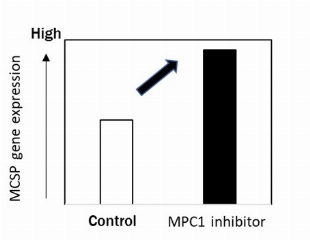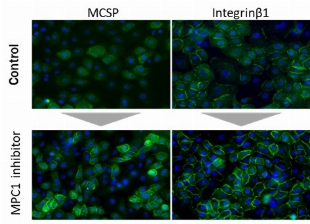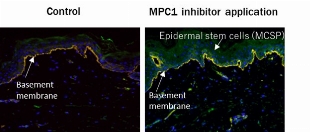May 16, 2023
(press release)
–
~Control of stem cells from the inside as a new approach to beautiful skin~ Shiseido has clarified that inhibiting MPC1*1, which controls ATP production*2 in mitochondria*3 that play a role in the generation of cellular energy, can increase human epidermal stem cells. In addition, it has discovered that the extract of Pleurotus cornucopiae var. citrinopileatus suppresses the expression of MPC1 in epidermal cells and thereby promotes activation of epidermal stem cells. These findings suggest the possibility of a new approach to beautiful skin via stem cells, that is, by putting the stem cells into a temporary resting state in which the production of energy is reduced, their activity can be stimulated, and the entire epidermal cells can be kept in a good condition. Figure 1. Inhibition of MPC1 activates epidermal stem cells Research background Skin turnover occurs as a result of cells in the epidermis constantly proliferating and differentiating, helping to maintain healthy skin. The source of these cells is epidermal stem cells, which are found in the basal layer located in the deepest part of the epidermis. Shiseido has been engaged in epidermal stem cell research for 10 years, believing that maintaining epidermal stem cells in a healthy state is very important for realizing youthful skin. As a result, we have discovered that supporting the maintenance of epidermal stem cells through the basement membrane, which lies below the basal layer of the epidermis, contributes to the retention of skin moisture and barrier function, and even the production of collagen in the dermis. Activation of epidermal stem cells by suppressing mitochondrial activity We focused on MPC1, a protein that supplies pyruvate (substrate for energy production) to mitochondria, and analyzed its effects on epidermal stem cells. When an inhibitor of MPC1 was added to cultured cells to suppress mitochondrial activity, the expression of MCSP gene*4, which is an epidermal stem cell marker, was increased (Figure 2). Moreover, in addition to the gene, an increase in epidermal stem cells themselves was also observed (Figure 3). It was also found that by applying the MPC1 inhibitor to cultured skin tissue, the number of epidermal stem cells in the skin also increased (Figure 4). These findings suggest that it is possible to activate epidermal stem cells by temporarily suppressing mitochondrial activity. Figure 2. Expression of epidermal stem cell marker (MCSP) gene in cultured cells Figure 3. Staining images of epidermal stem cell marker protein in cultured cells (MCSP, Integrin β1 Figure 4. Effect of MPC1 inhibitor in cultured skin (MCSP is stained in green color) Discovery of Pleurotus cornucopiae var. citrinopileatus extract having an inhibitory effect on MPC1 The finding that epidermal stem cells are activated by MPC1 inhibition led us to search for ingredients with MPC1 gene expression as an indicator. From among 124 candidate ingredients, we identified Pleurotus cornucopiae var. citrinopileatus extract having a suppressing effect on MPC1 expression (Figure 5). Figure 5. Effect of Pleurotus cornucopiae var. citrinopileatus extract suppressing MPC1 gene express Future prospects The results of this study suggest that, in epidermal stem cells as well, putting the cells in a state of ”rest” in which cellular energy production is temporarily suppressed can lead to activation of the cells, and as a result, the epidermal cells as a whole can be kept in a good condition. This strategy to control stem cells from the inside of cells (mitochondria) is a new approach to beautiful skin. Shiseido will continue to advance epidermal stem cell research to address various skin concerns related to aging. *The content of the release is correct as of the time of release, but please note that it may in some cases differ from the latest information.
This study has been carried out under ”Skin Beauty INNOVATION,” one of the three pillars of Shiseido's R&D strategy, leading to the generation of the latest knowledge from stem cell research in our company for 10 years. We will continue to strive to advance our stem cell research toward a future where it becomes possible to fundamentally reshape the skin.
*1 Mitochondrial pyruvate carrier 1 (MPC1): A protein that transports pyruvate necessary for ATP synthesis into mitochondria.
*2 ATP: Adenosine triphosphate. It is used as energy for various cellular activities.
*3 Mitochondria: Cell organelles that produce ATP by taking in the metabolites of sugars and lipids absorbed into the body from food.
Meanwhile, studies pertaining to in vivo stem cells including epidermal stem cells as well as the technology of development of iPS cells that won the Nobel Prize in Medicine or Physiology in 2012, are being promoted, as they are an important target in the areas of health and medicine. In recent years, it has become clear that the activity of mitochondria, the organelles that produce the cell’s energy, is low in in vivo stem cells, and it was scientifically proven that the stem cells are activated by being in this low energy state—the finding that has attracted much attention. Against this backdrop, we turned to this study under the hypothesis that, in epidermal stem cells as well, cell activation might be achieved by creating a low energy state.
*4 MCSP (Melanoma-associated Chondroitin Sulfate Proteoglycan): In this study, cells that express MCSP on the cell surface were treated as epidermal stem cells



About our R&D strategy:
This study has been carried out under ”Skin Beauty INNOVATION,” one of the three pillars of Shiseido's R&D strategy, leading to the generation of the latest knowledge from stem cell research in our company for 10 years.
- Integrated Report 2022 (Beauty Innovation Part)
https://corp.shiseido.com/report/en/2022/value_creation/innovation/
- Keywords
Skin Beauty INNOVATION, stem cell
【Related News Releases】
Shiseido discovers for the first time in the world that epidermal stem cells affect skin moisture (2015)
https://corp.shiseido.com/jp/newsimg/archive/00000000001832/1832_p2i83_jp.pdf
Shiseido develops a new active ingredient—a step closer to ”skin rejuvenation” for all customers (2018)
https://corp.shiseido.com/jp/news/detail.html?n=00000000002573
Shiseido confirms that maintaining epidermal stem cells contributes to dermal collagen fiber regeneration (2021)
https://corp.shiseido.com/jp/news/detail.html?n=00000000003159
* All content is copyrighted by Industry Intelligence, or the original respective author or source. You may not recirculate, redistrubte or publish the analysis and presentation included in the service without Industry Intelligence's prior written consent. Please review our terms of use.




